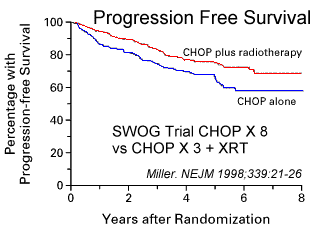Treatment of Aggressive Non Hodgkin's Lymphoma
Traditionally, radiation therapy had been the primary treatment of patients with stage I or contiguous stage II aggressive non-Hodgkin’s lymphoma (NHL). Radiation therapy alone can achieve long-term disease control within radiation fields in approximately 90% of treated patients. The dose of radiation ranges from 3,500 to 5,000 cGy and requires the use of megavoltage equipment. However, disease-free survival using radiation therapy alone is only 60% to 70% at 5 years.
The success of combination chemotherapy in early stage disease has led to combinations of chemotherapy and radiation therapy or to the use of chemotherapy alone. Two large randomized prospective trials document a better outcome with a combination of CHOP (cyclophosphamide + doxorubicin + vincristine + prednisone) and radiation therapy over CHOP alone. The Southwest Oncology Group randomized 401 patients with localized aggressive NHL (stage I or stage II) to 3 cycles of CHOP plus involved-field radiation therapy or to 8 cycles of CHOP. Overall survival at 5 years favored the combined modality arm (82% vs. 72%. The Eastern Cooperative Oncology Group randomized 210 patients with bulky stage I and all stage II disease who had attained complete remission with 8 cycles of CHOP to radiation therapy or to no further treatment. With a median follow-up of 6 years, the disease-free survival favors the combined modality arm (73% vs. 56% with no difference in overall survival. The British Columbia Cancer Agency treated 308 patients with early stage diffuse large cell lymphoma using 3 cycles of doxorubicin-containing chemotherapy followed by involved-field radiation therapy; with a median follow-up of 7 years, the 10-year overall and progression-free survival rates were 80% and 63%, respectively.
Extranodal sites may be involved with diffuse aggressive lymphoma without other sites of
involvement. These sites include the gastrointestinal tract, thyroid, and bone. Surgery
has an important role in the diagnosis and treatment of these primary extranodal lymphomas
with or without adjuvant radiation or combination chemotherapy. Since extranodal site
presentations often have an unpredictable pattern of relapse, chemotherapy is often used
as the primary treatment modality. As in patients with diffuse aggressive lymphoma in
nodal sites, however, adjuvant radiation to initial regions of disease following
chemotherapy appears to have the same improvement in disease-free and overall survival as
noted above.

